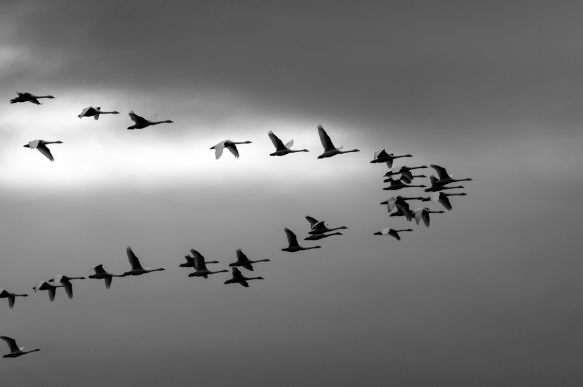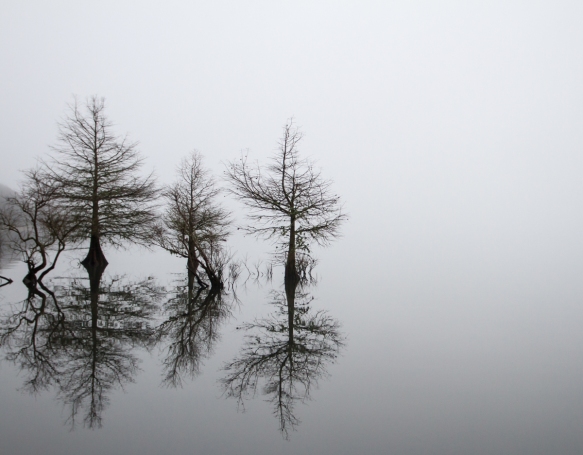Sunshine is delicious, rain is refreshing, wind braces us up, snow is exhilarating; there is really no such thing as bad weather, only different kinds of good weather.
~John Ruskin
My group last weekend certainly experienced most of these types of weather, something not that uncommon on an eastern North Carolina winter outing. I always fret about the weather for my groups, especially those interested in photography, but, I also know I can’t do anything about it. When we went down Thursday afternoon, it was beautiful, with an incredible sunset and sky full of Snow Geese. But, of course, the weather forecast for the weekend called for cold and rain, and then warming and rain, and even thunderstorms.
Part of the group arrived Thursday night and we were out before sunrise on Friday, with what looked like an overcast sky as we headed over to the refuge. Arriving at the observation platform a few minutes before sunrise, we were greeted with a brief, but stunning display of light shining up under the cloud cover. It vanished in about ten minutes, and I thought that would be the last sun we would see for the weekend.
We spent the morning looking for birds and photo opportunities with an increasingly gray sky. A few breaks in the clouds made for an interesting backdrop for bird silhouettes, both in color, and black and white.
One of the impoundments has been full of swans much of the winter, so we lingered there watching them interact and listening to the swan music. Lots of birds were flying over us as they left the lake to head out to the fields. providing the group with plenty of practice shooting what one participant called BIF (birds in flight).
With all the birds flying overhead, it soon prompted the swans we were watching on the water to join in, providing us with the challenge of capturing BTO (birds taking off). Waterfowl tend to take off into the wind, so, if you watch their behavior, you can often predict when they will make their move. Swans have to run across the water to gain enough speed for lift off. They often swim with the wind until they get to a place that provides a good runway of open water, then they will turn into the wind and start slowly swimming, often bobbing their heads. Then, they start running, slapping those large feet against the water, and flapping their 6 feet of wing span until they achieve lift-off.
Throughout the day, the skies darkened, making the use of the long lenses more difficult. After lunch we drove over to Lake Mattamuskeet. The lake surface was glassy, mirroring the leaden sky. But the wildlife was sparse, so we headed to back to Pungo for sunset, hoping to see the flocks of Snow Geese coming into the fields for a late meal.
At first, the fields contained only swans, lots of swans. I have rarely seen a flock of swans so densely packed as they were in one of the fields, heads up, necks bobbing, and squabbling with one another over the abundant corn lying on the field.
Then the unmistakable sound of incoming geese, and soon the sky was filled with a swarm of birds circling over the swans, trying to find a place to land. It is still a spectacle, even without the glow of an orange sunset like the night before.
The next morning continued the graying trend of the previous day, and black and white images seemed like the best way to relate the mood of the refuge. But, it would turn out to be an eventful morning, in spite of the clouds and drizzle.
The wet conditions made for very quiet woods-walking, so we headed into the trees, looking for signs of wildlife. And the signs were everywhere. We soon spotted a young bear, sitting against a large tree trunk. We all watched it, the bruin returning our gaze, until it finally stood up and ambled off into the thickets. We checked out its tree and found where it had been laying down. There was a nice pile of flattened, dry leaves where the bear had been laying, surrounded by wet leaves from the rain. There was also some chewing on the edges of a hollow leading under the base of the tree, as if the bear was trying to enlarge an access hole for an entryway. We continued on, noticing the abundance of bear and deer trails.
We soon spotted other bears, and, then, something I had hoped for – a bear in a tree. This young bear seemed totally undisturbed by our small group of camera-pointing humans, as it occasionally glanced our way, in between short naps. We spent some quality time with this bear, before heading back to the cars. Once out of the woods, I could see that thick fog was beginning to roll in, making a sunset show of Snow Geese unlikely. I have been there one other time this year when the fog obscured the birds coming into the field, even though I could hear them swirling overhead. So, we headed over to nearby Lake Phelps, the second largest natural lake in the state, at a little over 16,000 acres.
In all my trips over the years to this lake, I have never experienced the silvery curtain we had that afternoon. The water surface was glassy, and everything seemed suspended in a gray sky. The group posed on what one dubbed “the dock to nowhere”. The grayness seemed to absorb everything, including sounds.
It turned out to be a dramatic way to end our day – a colorless scene for the cameras and minds to record.
I thought the next morning would be the same, but we headed out before sun-up to Mattamuskeet anyway, some in the group hoping for a shimmer of predawn light. Much to my surprise, the sky did not disappoint. We had ten minutes of a stunning sunrise before the clouds pulled the curtain down on the stage.
The rains started early, at first a slow, spotty rain, then a few downpours to make me regret leaving my rain pants in my luggage. But, the ashen atmosphere enriched the colors, making the lichens and mosses on the trees pop in a way that is normally absent when sunlight paints the scene. The weather radar hinted at stronger rains headed our way, so we departed the refuge and headed west, hoping to get on the other side of what was looking like a strong storm front.
Goose Creek State Park welcomed us with overcast skies, rapidly warming temperatures, and no serious rain. The boardwalk behind the Visitor Center is a favorite of mine, especially in spring and summer when the frogs, insects, and other small critters are so prominent. Much to our surprise, a Southern Leopard Frog greeted us within a few feet of entering the swamp. The reflections on this winter day were beautiful, allowing us to peer into another world, beneath the surface, while being suspended in the world above.
Like at Mattamuskeet, the gray skies and palpable humidity enhanced the palette of the swamp, augmenting the colors and making for an ethereal landscape.
Once again, the clouds and approaching front did not dissuade the wildlife. We saw several species of woodpeckers and countless Yellow-rumped Warblers along the boardwalk, plus a total of five Bald Eagles soaring over the swamp and the Pamlico River, our last stop of the day. Weather radar again indicated an approaching front, this one with the potential for strong winds and heavy rain. We all agreed to head home, thankful for our time spent in the changing winter weather. If only it had snowed…




















Wonderful photos Mike!!
Thanks, Wendy. We should try to have lunch one day on one of my trips down that way.
Beautiful pictures.
Thanks, Paul.
Mike, speaking of “swan music” I wonder if you would give me permission to show your amazing swan photos (with full credit) behind the Portsmouth Symphony Orchestra performance of Sibelius 5. His main subject for writing the symphony was a flock of 16 swans circling over his head in a majestic moment. These are so beautiful and I think capture exactly what he was feeling.
Hi Dorothy:
You are certainly welcome to use whatever swan images might enhance the symphony piece. Please give me more details (email me directly at roadsendnaturalist@gmail.com). And let me know if you need them in higher resolution (and which) ones…there are many swan images on my blog – see this link for some of them – https://roadsendnaturalist.com/tag/pocosin-lakes-national-wildlife-refuge/.